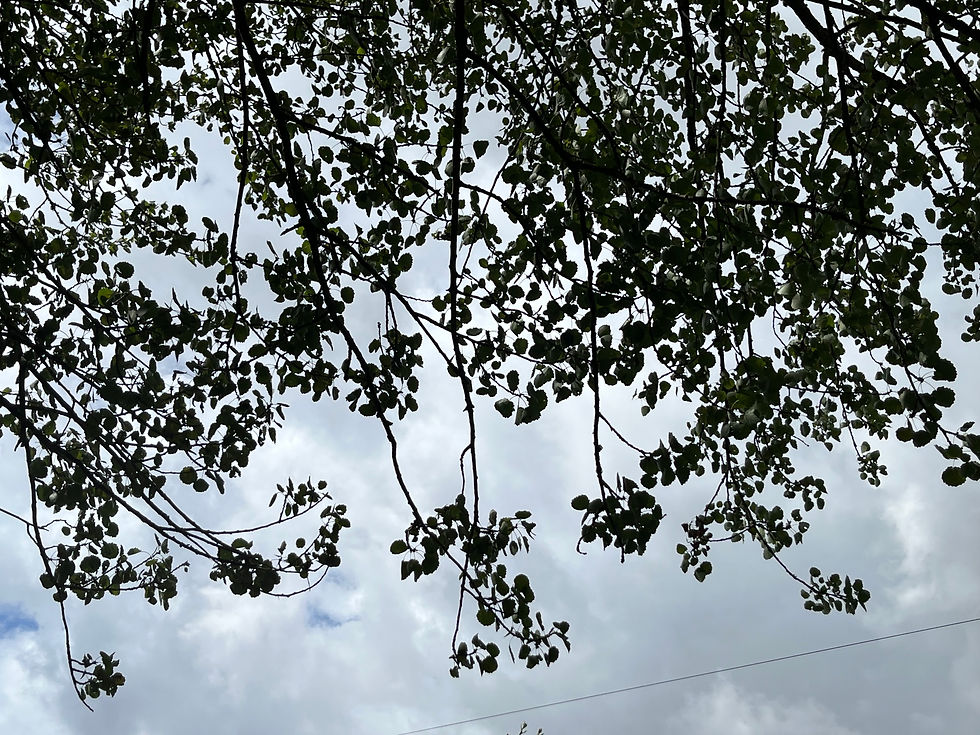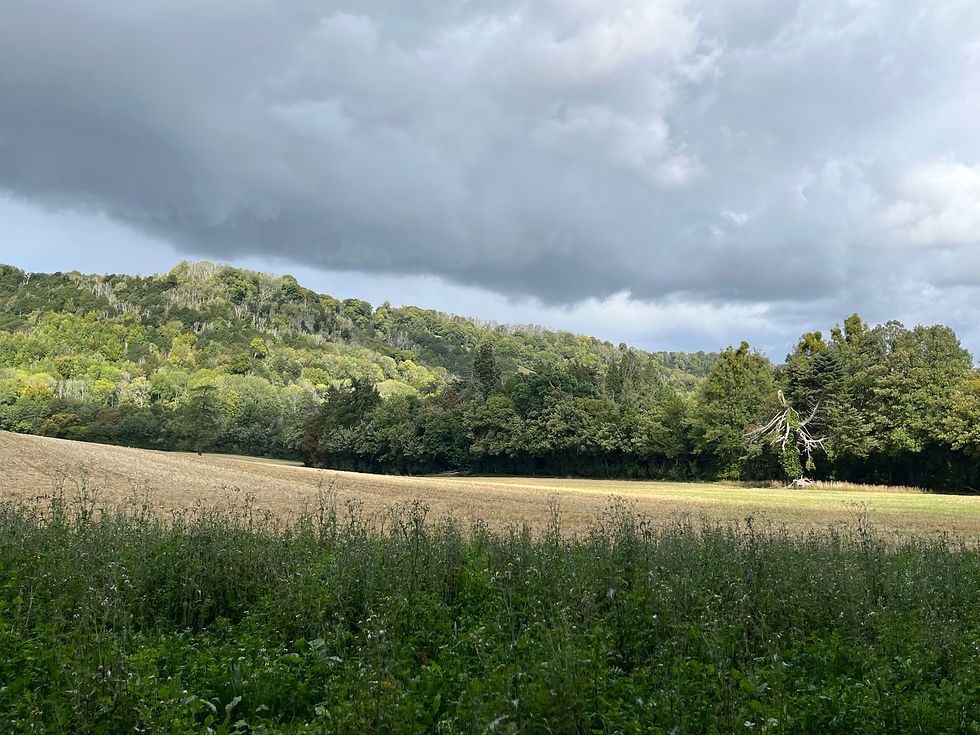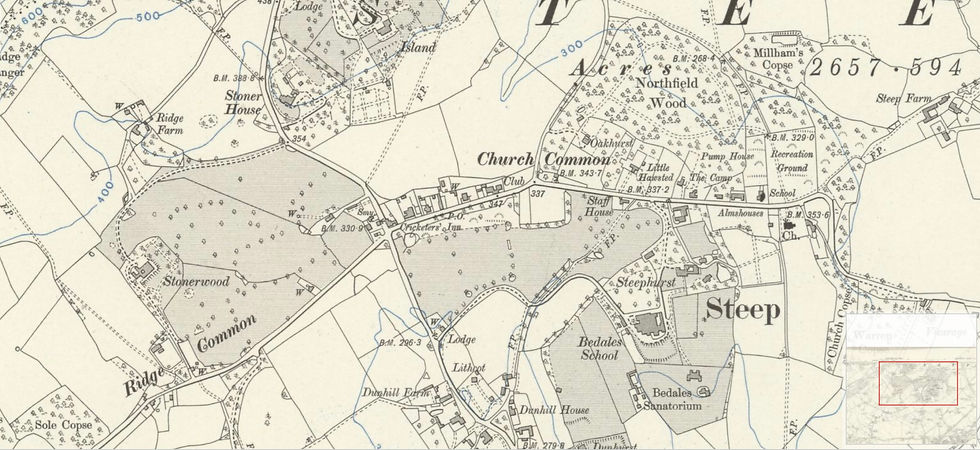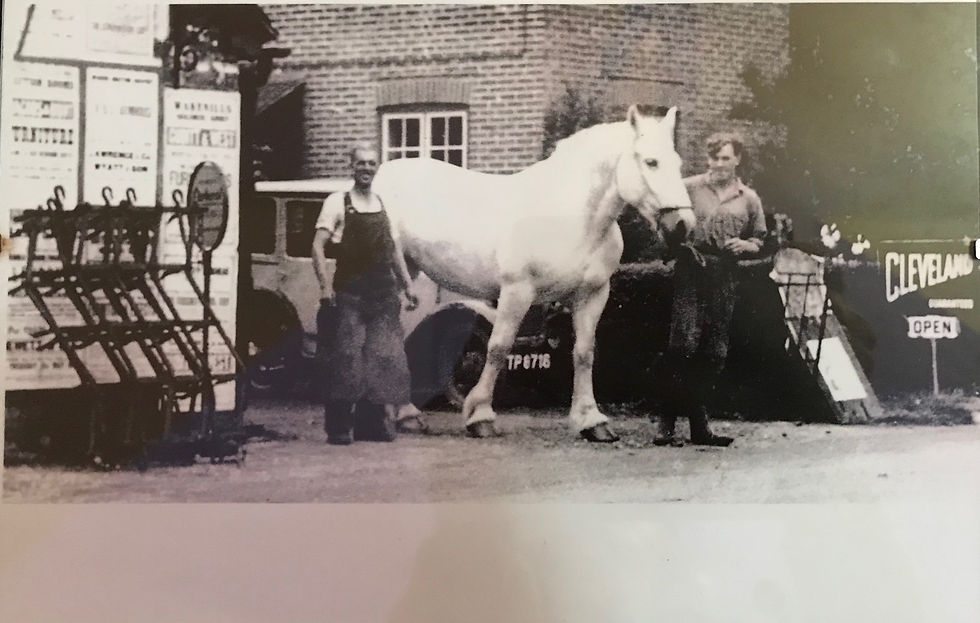Aspens
- nicholasjdenton
- Sep 8
- 14 min read

All day and night, save winter, every weather,
Above the inn, the smithy and the shop,
The aspens at the cross-roads talk together
Of rain, until their last leaves fall from the top.
Out of the blacksmith’s cavern comes the ringing
Of hammer, shoe, and anvil; out of the inn
The clink, the hum, the roar, the random singing -
The sounds that for these fifty years have been.
The whisper of the aspens is not drowned,
And over lightless pane and footless road,
Empty as sky, with every sound
Not ceasing, calls their ghosts from their abode,
A silent smithy, a silent inn, nor fails
In the bare moonlight, or thick-furred gloom,
In tempest or the night of nightingales,
To turn the cross-roads to a ghostly room.
And it would be the same were no house near.
Over all sorts of weather, men and times,
Aspens must shake their leaves and men may hear
But need not listen, more than to my rhymes.
Whatever wind blows, while they and I have leaves
We cannot other than an aspen be
That ceaselessly, unreasonably grieves,
Or so men think who like a different tree.
Aspens is the second poem Edward Thomas wrote as his farewell to Steep, before he went off to military training camp in the summer of 1915. Together with The Mill-Water and Two Houses (the third and last - see previous posts for both), in Aspens he was remembering the community and history of Steep and also an aspect of the natural world that had increasingly made a special impression on him.
Early on, soon after he had arrived in Steep in May 1907, he had jotted down a note about the wooded Ashford Stream, which rose in the parish: “Looking at bright water running & rippling round a curved steep sand bank at Steep Marsh I thought it was a pity that men had so long lived on this earth & not learnt these idioms of waters & winds among the leaves.”

Eight years later he was ready to write of these idioms. In The Mill-Water he wrote of the idiom of waters; in Aspens he wrote of the idiom of winds among the leaves.
Both are based on his own response to the experience, an immersion of, and inspiration for, thought, listening to the mill stream, and feelings of sad empathy and despair, hearing the rustle of the aspens.
Aspens are part of the poplar family. Its Latin name “”Populus tremula” coming from the trembling of its leaves in the wind. All poplars do this, but the aspen’s trembling is particularly noticeable as the edges of its leaves are serrated, and the wind through the serrations creates a sound as if the leaves are being rained upon.

ET was very familiar with all of the poplar family - noting not only aspens, but white, black and Lombardy poplars on his walks and other travels. He saw them in London, France , Gloucestershire (the Lombardy poplar), Wales and across the South Country, often in river valleys.
ET had to explain to his close friend, Eleanor Farjeon the ending of the poem - “About ‘Aspens’ you missed just the turn that I thought essential. I was the aspen. ‘We’ meant the trees and I with my dejected shyness. Does that clear it up, or do you thinking on re-reading it that I have not emphasised it enough?”
It seems to have cleared things up as the poem remains as in the original draft.
Robert Frost thought Aspens ET’s “loveliest of all to date” and needed no explanation. About this time Frost also wrote a poem about the wind in trees - The Sound of Trees - with a very different interpretation. Perhaps this was prompted by the sight of ET’s poem. Robert Frost’s poem can be found at the bottom of this post.

ET seems to have also regarded Aspens as one of his best poems. It was one of the six poems of his published by his friend James Guthrie at the Pear Tree Press towards the end of 1916, and it was also chosen by ET to be one of the eighteen of his poems selected for An Annual of New Poetry edited by his fellow-poet, Lascelles Abercrombie, published a month before ET was killed in March 1917.
The aspen trees he was writing about were at the cross-roads of Steep, opposite The Cricketers Pub, a couple of hundred yards from the Thomases’ third house in Steep, Yew Tree Cottage. In ET’s day there was also a smithy and a shop at the crossroads, as he mentioned in the poem. There is still one aspen there on Ridge Common Lane which rustles in the slightest breeze, and there are some other poplars, also there in ET’s day.
He had noted aspens (and poplars) at the crossroads from early on at Steep before he came to live so close by. He would have passed the crossroads on many occasions although he would have not had the day-to-day familiarity until he moved round the corner from them.

Rather than the sound of the aspens, he first noticed the blossom or “wool” falling off the trees in July:
“Cricketer’s corner strewn with white aspen wool”
“ Road pillowed with white down from aspens”
He may also have been referring to the aspens at the crossroads when writing in September 1908 “In still hot night now & then aspens rustle with sound as if the droughty night took a deep draught of something fresh & sweet between its lips.”

In November of the same year he wrote a more detailed description of poplars losing their leaves, something that he was to reflect in the poem:
“The leaves can be counted on the poplars & they whisper & flicker separately & then in faint E. wind. They fall in ones & twos as the tree waves greenlike in twilight. Then there are four - writing tragic words on the silver sky & they stay day after day when suddenly all 4 float down in still air.”
The “tragic words” were the specific idiom of aspens which also reflected his own character. For ET a number of experiences tended to evoke sadness in him - the cuckoo call, owls hooting in the hangers, ships passing him by on the sea or on the Thames in London. Sometimes he would be overtaken by sadness when looking at a view of land and sky as he did at Petworth, one December evening and noted: “The sadness of space as I look to the Downs at nightfall from Petworth - mere space so large that it drowns & drowses the wind.”
But from his earliest notebooks there was a particularly strong association in his mind between leaves and sadness. On 14th September 1906 before they had moved to Hampshire he noted: “In autumn the aerial heavenly colours desire heaven, the leaves earth, hence melancholy.”
He went on: “Sadder than the trees shedding their leaves - which indeed are but as fair & robust as others who have more than they lose - are those who have no leaves to shed & these at such a time imprecate & rage.”
In a note later in November 1906 he wrote “Thought at falling of leaves - sad not because they die but because they are by many unseen & because poetry has not monumentalised? them every one.”

Berryfield, their first home in Steep, lay directly under the beech and yew woods of the hangers. When he moved there, he would hear the woods en masse at night or as he walked up and down them. He heard them in a March storm shortly after they had moved:
“Beeches on beech-covered hill roar & strain in high wind as if they would fly off with the hill.”
In May he was writing of: “Sounds on a short summer night as many as leaves in wood.”
In June during another windy night “Then at midnight - still no rain - the plunging wind in the woods sounds like waterfalls like Loughor in Glynhir” (close to Llandeilo in Wales, a waterfall he knew well from his journeys in Wales.)

His fullest description of the hangers in a high wind after violent downpours occurred on 24th July 1909. After the rain had passed he wrote:
“Then the sun shines out of pure moist cool blue between white sunny clouds - all the woods roar with a new wet voice as branches thresh & foam out of light into shade & to & fro, all the woods alive like a sea, with countless greens in light & shade & greys & white (of beam) tossing all ways & yet harmoniously with one sound crossed by many lesser sounds. The fresh multitudinous joyous motion & sound of it over the wide space - earth as sweet as sky & as full of air. All that massiness turned to froth & sound.”
In contrast, in September of that year the wind was so slight that it “only crisps the rustling yellowed surface of wood so one hears the individual leaves but no roar with concerted whisper.”
A few years later he was writing “All day the Hangers sound as if an endless train were passing the other side of the hill”, an image he was to use in his first poem, Up in the wind.

Having listened in their first two houses, respectively below and above the hangers, to the mass of trees they bordered, there was no such aggregation in their third house. Instead he would have noticed the wind more in individual trees. As we have seen from his earliest notebooks he was well aware of aspens rustling, trembling, sighing, whispering, bowing…
From the summer of 1913, when he moved to Yew Tree Cottage, he had made regular notes about the aspens (and other poplars) at the crossroads down the road from their house. In August 1913 he was noting “an ever rustling poplar by ‘Cricketers’.

During October he wrote a number of notes as he observed the leaves of the aspens falling. On a hot day with no breath of wind he noted: “Sheet of new fallen poplar leaves all are glitter on road by “Cricketers” & beyond that are invisible genially cawing rooks in oaks. The pines of Old Stoner a whity (frosty looking) blue green among the now changing beeches.”
Later in the month on his walk up to his study he noted the colour of mangold leaves was a similar pale yellow to the aspens near the Cricketers which had only a few yellow topmost ones - although a larger poplar was still green and full leaved.

On the same way up to his study earlier in the summer he had also spotted some other aspens in Ashford Lane on a fine but cloudy morning :
“at 7.45: the 2 harmonious continuing sounds of:
1 aspens rustling by Bones.
2 bees overhead in big lime
& a great precipitating edged white cloud breasts the dark blue above lane hedge.
Same sounds at 1.30pm next day but aspens louder.”

In this note, Bones almost certainly refers to Sir Muirhead Bone (1876–1953), the celebrated Scottish etcher and draughtsman known for his detailed architectural and industrial subjects, and for being the first official War Artist during World War I and a War Artist in World War II. He lived with his family at Byways in Ashford Lane, possibly using it for weekends and holidays. Locally he was well known for being a moving spirit, and the largest donor, for the Steep War Memorial Village Hall in 1921.

From ET’s notebooks it is evident that his appreciation of aspens grew with his proximity to them at his third home at Steep. Increasingly in his notebooks he located a number of aspens precisely, something he rarely did with other trees, except that stalwart of the village green, the elm.
He had come across an aspen on a couple of visits to Terwick Mill, close to Trotton on the River Rother between Petersfield and Midhurst. On his first visit there in the summer of 1908 he had written of “neat shaven lawn & house with dark rooms behind square windows” and “huge aspens” above “mass of water & kingfisher & deep meads”.
Six years later, on a June day in 1914, he noted more specifically a dove crooning in the big aspen by the black boarded mill house. This visit was to be the inspiration for his poem, The Mill-Pond, the following year.

There was also a black poplar at the West end of Ridge Lane, in a hollow full of hazel, ash and travellers joy, on top of the hangers. Leaning over a gate he heard the poplar sigh while he enjoyed the panoramic view of Butser Hill, the sweep of War Down and the South Downs marching east. Elsewhere in his notebooks he had spotted aspens or other poplars in specific locations in Wilton in Wiltshire, Tewkesbury, Gloucestershire, Long Melford, Essex, Hurstbourne Park, Hampshire and in Wales in Blaensawdde, and the Inn at Pontrhydfendigaid.
He also spotted poplars at railway stations as he was passing through on the train. Some in the Surbiton railway yard caught his attention in June 1909 as he was travelling between London and Petersfield. He wrote: “Trees (poplar etc) blowing round Surbiton railway yard - trees blowing round the waters? of men singing with their fresh voices that the wind blows as sweet over a grave, as if all men were in their graves”. He also noted the down of the poplars “driving along railway like sparse snow.”
The poem goes beyond a memorialisation of Steep, the village, to reflect ET's close affiliation with the aspens and their sound not just at the crossroads but in many other places. At the time their sound would have chimed with his darker mood as he prepared to start military training with all the uncertainty that this would have entailed.
A walk

As we have seen ET would have walked regularly past the crossroads where the aspens were especially after they came to live at Yew Tree Cottage in 1913.
His most regular walk would have been up to his study, either along the road up Stoner Hill, now a busy road between Petersfield and Alton and Alresford. An alternative route took him along the path across the fields towards the hangers above The Cricketers pub, via Island Farm, past the Bones' house at Byways on Ashford Lane, then up the path to Ludcombe Pond and the Woodcutter’s path to the top of Ashford Hangers close to Cockshott Lane, where his study was.

Instead of a walk through Steep, which I have covered in other posts such as April and The Interval among others , I thought it would be interesting to do a walk through the past of the crossroads, which ET referred to in his poem. Almost all of this history is courtesy of Fran Box who ran the Steep History group for many years and still keeps the archive (https://historyofsteep.co.uk)

As ET suggested in the poem the crossroads had been a centre of Steep village for fifty years, at the other end of Church Road to All Saints parish church. The Cricketers Inn had been built by Henry Ifould in 1859. When he applied for a licence, he stated that the Inn had good accommodation, had eight rooms, stabling for six horses and a chaise house. It is known that he also ran a post office and shop from the pub. In ET’s day the pub landlord was William Budd, married to Justine Budd and they had two daughters , Nora and Rosamond who were close to Bronwen Thomas in age. There is a picture of Mrs Budd with Helen and Myfanwy in 1914 at the crossroads.

ET himself does not seem to have used the pub, preferring The White Horse, aka The Pub with No Name. This may have possibly have been a result of his aversion to socialising with teachers from Bedales.
William Budd was one of the longest serving landlords of The Cricketers, staying there for nearly 30 years. Early in his tenure the local brewers, George Gale and Co., brewers at Horndean bought the pub.
The pub was rebuilt, possibly after a fire in the 1930s. It is now a thriving pub in the Steep community, with a good range of beers, excellent food and comfortable accommodation (https://www.cricketersinn.com)

One of the previous landlords, Edwin Longhurst, when he had ceased to run the pub in 1896, had moved next door to 3 Church Road, where he ran the Steep shop and post office. He died in 1909, but his family were still at the shop in 1911 and would have almost certainly been there when ET wrote Aspens. Longhurst's 26 year old son William was the ‘grocer’ and his widowed 59 year old mother Elizabeth lived with him. By the 1970s Steep Village Stores had moved further along Church Road and was at the house known as The Old Post Office.
The smithy was on the site of the present cycle shop. It had been occupied by the Pocock family in mid 1800s, then the Hounsome family in the late 1800s. Henry Hounsome was the blacksmith there in 1901. By 1908 it seems to have become unfit for habitation. There was a case about it reported in the Hampshire Post and Southsea Observer on 20th March 1908. Henry Hounsome was still living there and refusing to move , but his wife Bertha was living at Steep Almshouses. Henry eventually ended up in Petersfield workhouse where he died. It’s not known who took over the smithy after he moved out, but it was evidently still active while the Thomas family lived at Yew Tree Cottage. ET noted in one of his notebooks of the time a hunt meeting outside the smithy.
By the 1950s, possibly earlier, the Moss family had taken over the smithy. Tommy Moss was a much loved local farrier - see photograph below.

In the late 1960s the smithy closed and was replaced by a garage, which has now been superseded by a bicycle shop. A replica of the hearth of the smithy was rebuilt at Lords Farm, between Sheet and Petersfield as shown in this picture from 2021 courtesy of Fran Box:

WM Whiteman wrote about the cross-roads in his book, Edward Thomas Country in 1978, “A hundred and fifty yards from Yew Tree Cottages is the crossroads of the poem ‘Aspens’…. The inn, the Cricketers has been rebuilt and now stands back behind a car park. Tom Moss’s smithy, an old squatter’s encroachment on the waste, was replaced less than 10 years ago by a garage. The cross-roads shop too has gone, but the poplars still whisper in the smallest breeze.”
The crossroads has now been a centre of the community of Steep village for over 150 years and there are still both poplars and aspens at the crossroads. Much of what ET saw and noted of the natural world is surprisingly still there, except the birds which are sadly much depleted and elms and ash have either disappeared or are disappearing. However the natural world clings on and even flourishes in many corners, including the copses opposite The Cricketers. And the sound of Thomas’s aspen can still reflect or even conjure up a mood if you listen for long enough (and avoid the cars!)

The sound of trees by Robert Frost (1916)
I wonder about the trees.
Why do we wish to bear
Forever the noise of these
More than another noise
So close to our dwelling place?
We suffer them by the day
Till we lose all measure of pace,
And fixity in our joys,
And acquire a listening air.
They are that that talks of going
But never gets away;
And that talks no less for knowing,
As it grows wiser and older,
That now it means to stay.
My feet tug at the floor
And my head sways to my shoulder
Sometimes when I watch trees sway,
From the window or the door.
I shall set forth for somewhere,
I shall make the reckless choice
Some day when they are in voice
And tossing so as to scare
The white clouds over them on.
I shall have less to say,
But I shall be gone.

Acknowledgements
Edward Thomas Field Note Books copyright Henry W. and Albert A. Berg Collection, New York.
Transcription of the Edward Thomas Field Note Books quoted in this and other posts are available at the Edward Thomas Centre in the Petersfield Museum.
My great thanks to Fran Box, previously of Steep History Group and now keeper of the Steep History Archive for all her help and the fascinating information about the crossroads at Steep and its surroundings. https://historyofsteep.co.uk
The photograph of The Cricketers is courtesy of Fran Box and copyright of The Harrow Collection. The photographs of the smithy hearth and picture of Tom Moss courtesy of and copyright of Fran Box and the Steep History archive. Photographs of Helen and Myfanwy Thomas at the crossroads are courtesy of Richard Emeny’s Edward Thomas: A Life in pictures. More old photographs of The Cricketers and its history can be found on The History of Steep website - https://historyofsteep.co.uk/portfolio/a-small-amount-of-history-of-the-cricketers-inn-steepa-small-amount-of-history-of-the-cricketers-inn-steep/
Thanks as always to Benedict Mackay for editorial support.



Comments